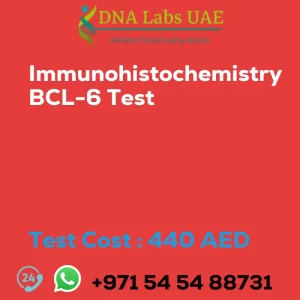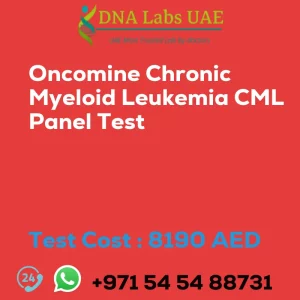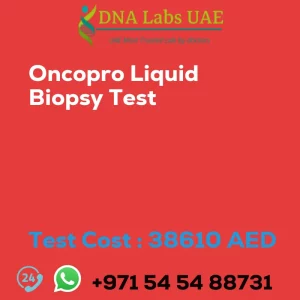IMMUNOHISTOCHEMISTRY CYTOMEGALOVIRUS CMV Test
Test Name: IMMUNOHISTOCHEMISTRY CYTOMEGALOVIRUS CMV Test
Components: Immunohistochemistry (IHC) technique to detect specific CMV antigens
Price: 430.0 AED
Sample Condition: Submit tumor tissue in 10% Formal-saline or Formalin fixed paraffin embedded block. Ship at room temperature. Provide a copy of the Histopathology report, Site of biopsy, and Clinical history.
Report Delivery: Sample Daily by 6 pm; Report Block: 5 days, Tissue Biopsy: 5 days, Tissue large complex: 7 days
Method: Immunohistochemistry
Test Type: Cancer
Doctor: Oncologist, Pathologist
Test Department: DNA Labs UAE
Pre Test Information: Provide a copy of the Histopathology report, Site of biopsy, and Clinical history.
Test Details
Immunohistochemistry (IHC) is a technique used in pathology to detect specific proteins or antigens in tissue samples. In the case of cytomegalovirus (CMV) testing, IHC can be used to detect the presence of CMV antigens in tissue samples.
The immunohistochemistry CMV test involves the following steps:
- Tissue Sample Preparation: A tissue sample suspected to be infected with CMV is collected, usually through a biopsy or surgery. The tissue sample is then fixed and embedded in paraffin to preserve its structure.
- Sectioning: The paraffin-embedded tissue sample is cut into thin sections using a microtome. These sections are then mounted onto glass slides.
- Deparaffinization and Rehydration: The paraffin is removed from the tissue sections using a series of solvents, typically xylene and graded alcohols. This process is called deparaffinization. The tissue sections are then rehydrated by placing them in a series of graded alcohols.
- Antigen Retrieval: In some cases, antigen retrieval is required to unmask the CMV antigens and make them accessible for antibody binding. This can be done using heat-induced epitope retrieval methods or enzymatic digestion.
- Blocking: The tissue sections are then treated with a blocking agent, such as normal serum or bovine serum albumin, to prevent non-specific antibody binding.
- Primary Antibody Incubation: The tissue sections are incubated with a primary antibody specific to CMV antigens. This antibody recognizes and binds to the CMV antigens present in the tissue sample.
- Secondary Antibody Incubation: After washing away any unbound primary antibody, the tissue sections are incubated with a secondary antibody conjugated to a detection molecule, such as an enzyme or fluorescent dye. This secondary antibody binds to the primary antibody, allowing for the visualization of CMV antigens.
- Visualization: If an enzyme-linked secondary antibody is used, a chromogenic substrate is added, which reacts with the enzyme to produce a visible color change. If a fluorescent dye is used, the tissue sections are visualized using a fluorescence microscope.
- Interpretation: The stained tissue sections are examined under a microscope by a pathologist. The presence or absence of CMV antigens in the tissue sample is assessed based on the specific staining pattern and localization of the antigens.
Immunohistochemistry CMV testing can be used to diagnose CMV infection in various tissues, including organs affected by CMV-related diseases such as pneumonia, hepatitis, and retinitis. It can also be used to monitor the effectiveness of antiviral treatment and to study the distribution and localization of CMV in tissues.
| Test Name | IMMUNOHISTOCHEMISTRY CYTOMEGALOVIRUS CMV Test |
|---|---|
| Components | |
| Price | 430.0 AED |
| Sample Condition | Submit tumor tissue in 10% Formal-saline OR Formalin fixed paraffin embedded block. Ship at room temperature. Provide a copy of the Histopathology report, Site of biopsy and Clinical history. |
| Report Delivery | Sample Daily by 6 pm; ReportBlock: 5 days Tissue Biopsy: 5 days Tissue large complex : 7 days |
| Method | Immunohistochemistry |
| Test type | Cancer |
| Doctor | Oncologist, Pathologist |
| Test Department: | |
| Pre Test Information | Provide a copy of the Histopathology report, Site of biopsy and Clinical history. |
| Test Details |
Immunohistochemistry (IHC) is a technique used in pathology to detect specific proteins or antigens in tissue samples. In the case of cytomegalovirus (CMV) testing, IHC can be used to detect the presence of CMV antigens in tissue samples. To perform an immunohistochemistry CMV test, the following steps are typically followed: 1. Tissue Sample Preparation: A tissue sample suspected to be infected with CMV is collected, usually through a biopsy or surgery. The tissue sample is then fixed and embedded in paraffin to preserve its structure. 2. Sectioning: The paraffin-embedded tissue sample is cut into thin sections using a microtome. These sections are then mounted onto glass slides. 3. Deparaffinization and Rehydration: The paraffin is removed from the tissue sections using a series of solvents, typically xylene and graded alcohols. This process is called deparaffinization. The tissue sections are then rehydrated by placing them in a series of graded alcohols. 4. Antigen Retrieval: In some cases, antigen retrieval is required to unmask the CMV antigens and make them accessible for antibody binding. This can be done using heat-induced epitope retrieval methods or enzymatic digestion. 5. Blocking: The tissue sections are then treated with a blocking agent, such as normal serum or bovine serum albumin, to prevent non-specific antibody binding. 6. Primary Antibody Incubation: The tissue sections are incubated with a primary antibody specific to CMV antigens. This antibody recognizes and binds to the CMV antigens present in the tissue sample. 7. Secondary Antibody Incubation: After washing away any unbound primary antibody, the tissue sections are incubated with a secondary antibody conjugated to a detection molecule, such as an enzyme or fluorescent dye. This secondary antibody binds to the primary antibody, allowing for the visualization of CMV antigens. 8. Visualization: If an enzyme-linked secondary antibody is used, a chromogenic substrate is added, which reacts with the enzyme to produce a visible color change. If a fluorescent dye is used, the tissue sections are visualized using a fluorescence microscope. 9. Interpretation: The stained tissue sections are examined under a microscope by a pathologist. The presence or absence of CMV antigens in the tissue sample is assessed based on the specific staining pattern and localization of the antigens. Immunohistochemistry CMV testing can be used to diagnose CMV infection in various tissues, including organs affected by CMV-related diseases such as pneumonia, hepatitis, and retinitis. It can also be used to monitor the effectiveness of antiviral treatment and to study the distribution and localization of CMV in tissues. |








